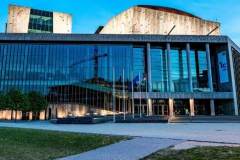Sondorgo and Balanescu Quartet
March 2026 | ||||||
|---|---|---|---|---|---|---|
Mo | Tu | We | Th | Fr | Sa | Su |
World music, jazz, popular music
Söndörgő & Balanescu Quartet
From Meadow to Metropolis – In Bartók’s Footsteps
Two vastly different yet mutually enriching musical universes meet on the Müpa stage this evening: Söndörgő, one of Hungary’s most exciting representatives of Balkan and South Slavic musical traditions, and the world-renowned Balanescu Quartet, which masterfully combines contemporary classical music with boundary-defying creative improvisation. The backbone of the concert is provided by the music of Béla Bartók, but reimagined in a new light: the Balanescu Quartet’s minimalist, avant-garde sensibility and Söndörgő’s infectious tambura music are sure to create a unique sonic world. The works to be performed will build bridges between classical and folk music, past and present, the Balkans and Central Europe. Alongside Söndörgő’s original compositions, Bartók’s folk music collections will come to life as contemporary chamber music arrangements, while the sound of Southern Slavic tamburas will be presented in a context rarely heard on Hungarian stages.
Program and cast
Söndörgő:
prime tambura, tambura samica, darbuka, vocals - Áron Eredics
viola tambura, trumpet, vocals - Benjámin Eredics
clarinet, saxophone, kaval, prime tambura, bass prime tambura, vocals - Dávid Eredics
accordion, flute, hulusi, bass prime tambura - Salamon Eredics
double bass - Ábel Dénes
Balanescu Quartet:
1st violin - Alexander Bãlãnescu
2nd violin - James Shenton
viola - Helen Kamminga
cello - Nicholas Holland
Palace of Arts Müpa Budapest
When Müpa Budapest, Hungary and its capital's new cultural hub, opened in 2005, it was built to represent more than 100 years of Hungarian cultural history. As a conglomeration of cultural venues, the building has no precedent in 20th century Hungarian architecture and has no peers in the whole of Central Europe.
The creators of this ambitious project, the Trigránit Development Corporation, prime contractor Arcadom Construction and the Zoboki, Demeter and Partners Architectural Office, were driven by the desire to create a new European cultural citadel as part of the new Millennium City Centre complex along the UNESCO World Heritage-listed Danube waterfront. The result is a facility whose construction quality, appearance, functionality and 21st century technological infrastructure makes it ideally suited to productions of the highest standard. The building is also highly versatile and equipped to host performances of any genre and almost any scale.

 EN
EN DE
DE IT
IT FR
FR ES
ES RU
RU JP
JP RO
RO
 Seating plan
Seating plan 
